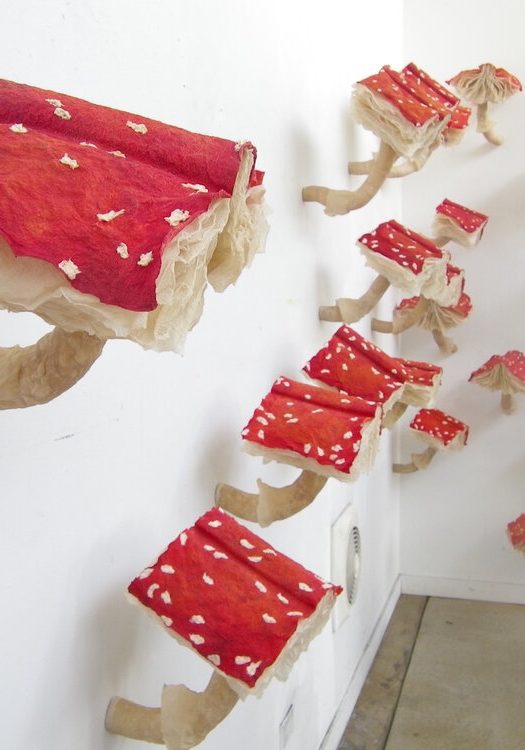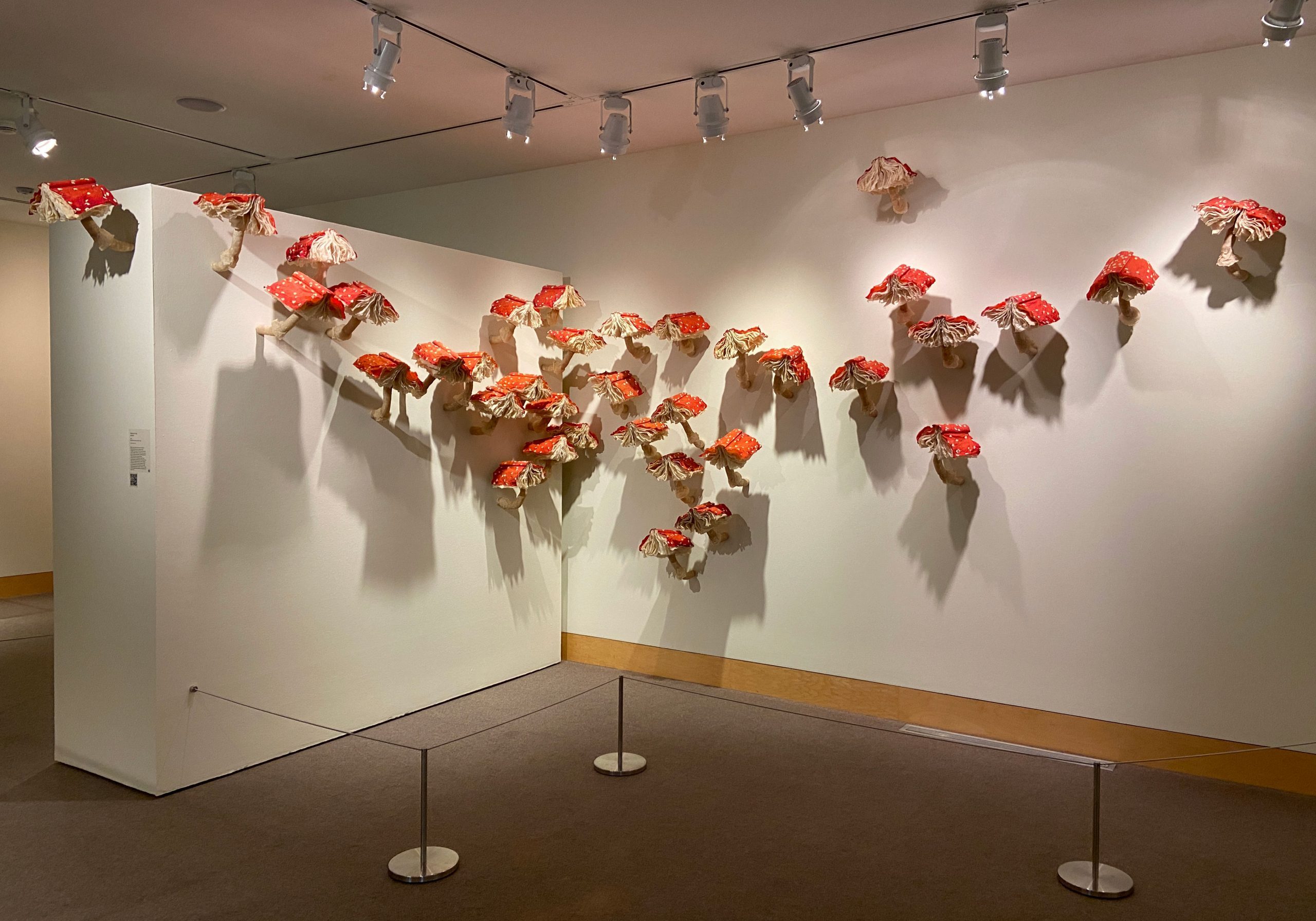Bio:
Melissa Jay Craig is a sculptor, book and installation artist whose primary medium is handmade paper. She lives and works in Chicago, where her work is represented by ZIA Gallery. It is included in museum, rare book, print and artists’ book collections throughout the United States. Melissa has been awarded numerous residencies and fellowships, including the National Endowment for the Arts studio residency at Women’s Studio Workshop. She is a Distinguished Resident at the Ragdale Foundation, where she was also a Prairie Fellow.
Artist Statement:
“The substantial words are in the ground and sea…”
~Walt Whitman
What happens when we read? We can become fully engaged, inspired, enraged, moved or so thoroughly intrigued that hours pass deep inside our books. And yet, we are physically inert. Reading text as a conventional linear dispersal of information seems to be an act altogether dissociated from our bodies.
We are continually, though too often unconsciously, reading in countless other ways: facial expressions, body language, textures and scents, as well as emotional, climatic and atmospheric charges. Our responses to these incessant, nuanced readings are vital to our movement through our lives; indeed, to our survival. Without our capacity for sensory readings, I suspect we would have developed neither the means to write nor to engage with writing.
Why, then, do we privilege and exalt only the knowledge acquired through written or spoken language? When we willfully trivialize our sensory and intuitive intelligences, we also detach from all but the most superficial aspects of our environment.
I am nearly deaf. I hear with my eyes. When I communicate with people, I read lips while simultaneously observing unspoken nuances to provide context, which also often reveals subtexts. Walking alone in nature is a lifelong source of fascination. Away from the obligation to process spoken words, I am free to interpret my environment in the same multifaceted, minute ways I comprehend speech, and to become as absorbed as I do when I’m reading the most compelling novel or provocative essay.
I use those experiences to imply narratives authored by our beleaguered planet, set forth in languages long overlooked by humanity’s intellectual arrogance. I perceive this as a language of dichotomy, of adaptation, of infinite cyclical renewal, of double-edged humor, of fierce, disturbing beauty and always, of the ultimate triumph of time.
Contact:
Melissa Jay Craig, (S)Edition
2010
Abaca fiber, dyes, and cotton rag
Collection of the artist.
Abaca fiber, dyes, and cotton rag
Collection of the artist.
When I was a child, the first time I had the intriguing feeling that the planet carried messages (texts, if you will) for those who were curious enough to look, was when I came upon a group of Amanita muscaria, huddled together in a dark, secret space under tall pines.
It seems odd to be exhibiting a work that is essentially about protest just at this pivotal time. When I'm installing the work, I often configure the books to mirror a secret meeting of some sort, where only a couple of books are visible until one goes round a corner, then turns to find an entire gathering of seditious fungi gathered in the corner.
(S)Edition is both a limited edition and an installation. (S)Edition consists of exactly 99 copies (36 are exhibited at the Dubuque Museum of Art). Materials: cast and hand-shaped abaca; covers dyed and embellished with cotton rag.
About (S)Edition:
Why was the mushroom invited to the party?
Because he was such a fun-gi. (thanks and a toast of Lake Erie water to Mira Bartok)
Edition: A particular form or version of a published book.
Sedition: Conduct inciting people to rebel against the authority of a state.
Clive Philpott, once in charge of book acquisitions at MOMA, stated that artists’ books were not artists’ books unless they were part of an edition of at least 100 copies. His opinions are often still embraced, particularly in academic environs.
A few activities that have been defined as sedition by the United States government: “secret machinations” (Alien and Sedition Act, 1789); “teaching, suggesting, defending or advocating any criticism of the government,” including to “utter, print, write or publish” such ideas (Espionage Act, 1917). More recently, there was “domestic terrorism”, which could easily be interpreted to include environmental and anti- globalization activism (The Patriot Act, 2001). While sedition can consist of overt action, it can also be furtive, undermining from within.
Some people have uneasy, squeamish thoughts when they look at fungus: it’s something surreptitious, uncontrollable; it lives hidden underground in familiar locales, ready to spring to life unexpectedly, and it often manifests itself as part of the demise of another organism.
Fungus is an agent of change. I’m fascinated with its myriad forms and colors, and I love to go in search of it. I can become more excited by discovering a beautiful fungal growth than by perusing artwork ‘discovered’ for us by curators in contemporary museums.
Amanita muscaria, also known as Fly Agaric, is a fungus that can be found almost worldwide. It is distinctive, clownish in appearance, the ‘toadstool’ of familiar fairy tale illustrations (A literary fungus, said Marcia Peck). Its image is so pervasive, many people don’t realize that it exists in nature, is not a fictitious creation. Amanita muscaria is psychoactive, and is thought by many to be the source of the ancient shamanistic drug of knowledge, Soma. Reportedly, it is still in use as a ritual sacrament in certain Siberian tribes, and its use has been mythically linked to many ancient religions, including Christianity. Most shamanistic spiritual beliefs embody what would today be called an environmentalist viewpoint; they are also mystical, embrace and honor intuitive acumen, the polar opposite of rigid, academic intellectualism.
As I worked on the first 27 copies of (S)Edition for a month at the Ragdale Foundation in Lake Forest, Illinois, the area was inundated by continuous, copious thunderstorms, a manifestation of global environmental change. A huge, amazing variety of fungi appeared as a result.
Amanita muscaria was not among them.
Amanita muscaria is classified as poisonous by the Food and Drug administration. I do not advocate its use, but admire the respect for our planet and for our intuitive intelligence its use may once have conveyed. (S)Edition was created with the support of: A Henry Faurest Fellowship and residency for Artist-Educators at Mary Anderson Center for the Arts, two residencies at the Ragdale Foundation, Full Fellowship residencies at the Vermont Studio Center, and the Jentel Foundation. Studio assistants for (S)Edition were: Jenny Kim, JE Baker, Cecile Webster, and Heather Grover Bella.


